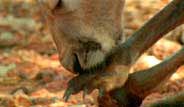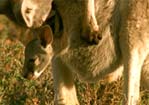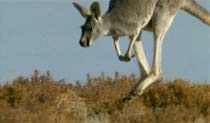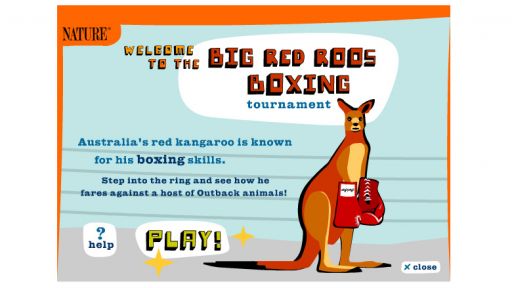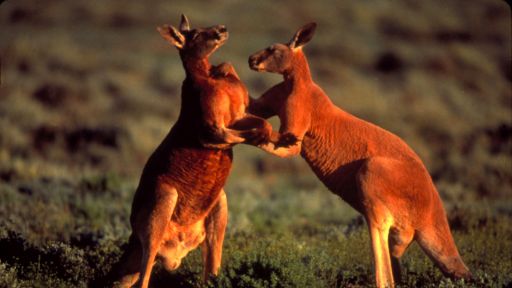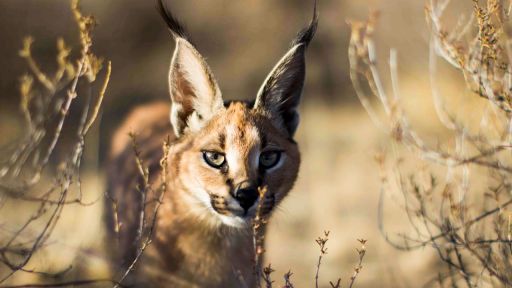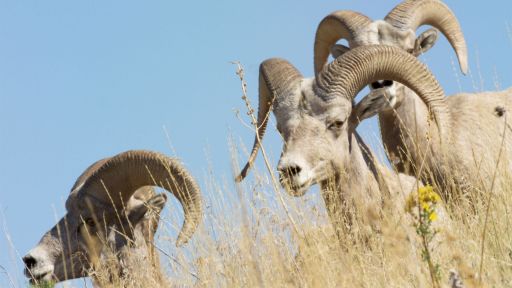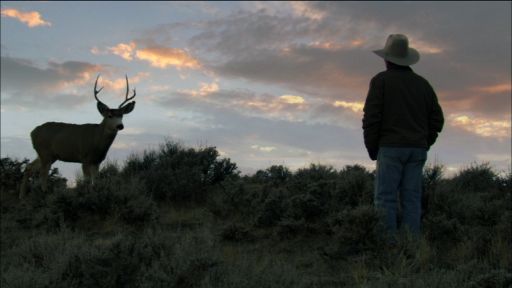THREAT #1: Intense heat
RESPONSE: Self–cooling efforts
A summer day in the Outback can mean temperatures well over 100 degrees Fahrenheit. How does the kangaroo survive in such blistering heat?
Most mammals cope with excess body heat by sweating. Kangaroos are unique in that they sweat while they’re hopping, but once they come to a halt, they stop sweating and start panting — up to 300 breaths per minute, keeping a nearly constant flow of air over their windpipes — to keep from overheating.
Another cooling system unique to kangaroo anatomy: a network of hundreds of small blood vessels just under the surface if their forearms. To stay cool, the roos lick their arms; the moisture on their skin evaporates to cool their warm blood.
THREAT #2: Thirst
RESPONSE: Efficient energy burning
Hot and arid, the Outback is an easy place in which to die of thirst — but taking the time to stop at the water hole puts the roo at risk from predators like dingoes, who may ambush them while they drink. How does the roo stay alive between trips to the oasis?
While hopping may seem like an odd way to get around, it’s actually one of the most efficient ways to travel on the planet. The faster they hop, the less energy kangaroos burn (at least up to about 20 miles per hour, which is their average cruising speed).
Kangaroos have extra-strong calves, a giant bundle of tendons that reach from their tails to their hipbones, and hind feet that work like a pair of springs. Add to that the fact that the tail acts as a rudder, allowing the roo to bound up to 30 feet and change direction in midair, and you have the closest thing to a perpetual-motion machine in the animal kingdom. Given their uniquely efficient body design, kangaroos can conserve enough energy to keep drinks to a minimum, lessening their risk.
THREAT #3: Predators
RESPONSE: Marsupial pouch
While all roos have predators to worry about, roo babies, or joeys, are the most susceptible prey. From Wedgetail eagles in the sky to fierce dingoes prowling the landscape below, the young kangaroo has its fair share of enemies hoping to turn it into lunch — and threaten the next generation, which has only a 40 percent chance of making it out of childhood. How does a small roo survive?
For a joey, the marsupial pouch serves as an all-purpose tote bag, minivan, and emergency hiding place. When she’s born, the average joey is tiny — about the size of a peanut — blind, and completely helpless. Bu unlike some other mammals that stand and walk at birth, the newborn joey isn’t expected to do much: she’ll crawl into the pouch and stay there for weeks, suckling constantly. As she grows heavier, a bone at the base of her mother’s pouch helps support the joey’s weight.
Once the joey ventures into the outside world, the pouch is her first place of refuge. The Wedgetail eagle is a fast enough flier to overtake a kangaroo hopping at full speed — 40 miles per hour — and has talons strong enough to latch onto a joey and carry her off. That means that the safest place to be is in mom’s pouch, where she can contract a muscle to safely seal her baby in.
THREAT #4: Dying out
RESPONSE: Boxing
The kangaroo group, or mob, is full of males vying for the attention of its females. The males of a mob form a hierarchy based mainly on age and size. The dominant male, called a boomer, gets to mate and sire the next generation, while the loser sees his line die out. How does a male kangaroo ensure the continuation of his line?
Male kangaroos settle their disputes in a simple and fascinating way: they box. Using their forearms to punch and their hind legs to kick, they spar in the Outback, and the roo left standing wins the prize: the available female, and a new baby. Kangaroos are perfectly designed for hand-to-hand cobat. As males get older, they grow much larger in proportion to females — they can weigh 200 pounds at full growth, up to five times the weight of females — with long, thickly muscled arms that pack a powerful punch and broad, strong chests to withstand a punishing kick. Adult males constantly spar with one another to keep in shape, posturing to intimidate one another by looking tough to beat.

